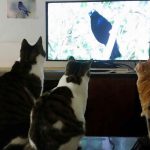We are losing species of birds, along with every other type of living creature, at a rate unprecedented in history. Dr. Stuart Pimm, world-renowned conservation biologist, summarized the severity of the situation in an 1998 interview with the American Museum of Natural History:
There are about 10,000 species of birds on the planet at the moment. If those species were going extinct at a geological rate, we ought to see one extinction about every 100 years. In other words, it ought to be, at best, a one-in-a-lifetime event. I have seen species that are now extinct — several of them — extinctions that I have known and hated. It’s not hard to go around the world and say good-bye to about one or two or three species per year. That very immediacy of those extinctions — of birds that we know very well — tells us that the current extinction crisis represents an extinction rate that must be at least 100 times what it ought to be.
It’s so easy to get caught up in the lament over loss of species that we sometimes forget that there are at least a few feathered friends as yet unmet. Just recently, in fact, a bird species has been added to the plus, rather than the minus, column, as reported by Birdlife International. Please welcome the Serendib Scops Owl.
The Serendib Scops-Owl (Otus thilohoffmanni) is a small, short-tailed scops-owl. This bird lacks apparent ear-tufts and has a weakly-defined facial disk. Small, rufous, and earless, the Serendib Scops Owl is quite unlike any other owl in Sri Lanka or anywhere else in the Indian subcontintent. Its closest relative is the Reddish Scops Owl (Otus rufescens) which ranges from Thailand to Indonesia. The Serendib joins 47 other species of the Otus genus, all members of the family Strigidae, which are commonly known as ‘typical owls’ as opposed to Tytonidae, or barn owls. Screech owls, sometimes given the genus Megascops, are also considered part of the Otus entourage. These owls can be found all over the world.
More than fifty years ago, an authority on the matter stated, “It is most improbable that a bird entirely new to science could now exist in Ceylon.” How is it, then, that a new species could be discovered on the Resplendent Isle for the first time since 1868? Birders know that, in the field, ears come before eyes. Deepal H. Warakagoda, a bird watcher with a background in electronics, first heard the Serendib’s unfamiliar call in 1995. He was able to tape the vocalization at a number of opportunities, but didn’t spot his quarry until January of 2001. The next month, a photographer captured the very first photos of the serendipitous scops. True capture, via mist-net, occurred in August of that year. Now that the bird’s discovery has been published in the Bulletin of the British Ornithologist’s Club (Vol. 124, 2004) we can accept it as official.
The good news is that we have a new bird. The bad news is that it’s already endangered. The Serendib Scops Owl is only found in the government-protected lowland rainforests of the south-west quarter of Sri Lanka. Like so many species, it seems to require unbroken tracts of a certain size. As of January 2004, only 45 individuals have been counted. There may be more, but it is likely that the boundaries of its habitat exert a terminal cap on the owls’ potential population.
With luck, we will continue to discover brand new bird species faster than we lose them. But as fortune gives, it also takes away. Consider the poor Cozumel Thrasher, endemic to that resort island off the coast of Mexico. At one time, the thrasher population numbered about 10,000, but most of them apparently died in the wake of Hurricane Gilbert in 1988. Right now, their numbers have dwindled a bit; as far as anyone knows, there is only one Cozumel Thrasher left. So, don’t expect us to change the name of this site just yet.













Leave a Comment